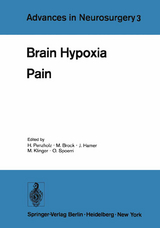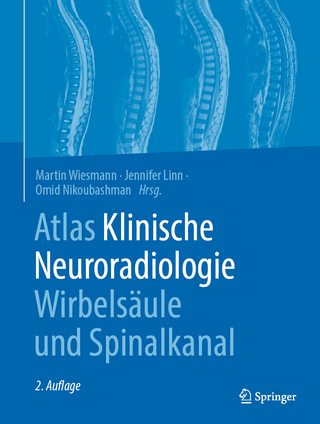Brain Hypoxia
Springer Berlin (Verlag)
978-3-540-07466-3 (ISBN)
Brain Hypoxia.- Neuropathology of Cerebral Hypoxia.- Effects of Different Hemodynamic Condititions on Brain Capillaries: Alveolar Hypoxia, Hypovolemic Hypotension, and Oubain Edema.- Pathophysiological Aspects of Cerebral Hypoxia.- Activation of a Cortical Seizure Focus Under Hypoxia: O2-Deficiency Effect or Result of Tissue Acidosis?.- Cerebral Oxygen Consumption in Profound Arterial Hypoxemia and Hypocapnia.- Development and Time Course of Blood Brain Barrier Disturbances Caused by Hypoxia.- The Influence of Ventricular Perfusion on Normal Brain.- Biochemical Aspects of Cerebral Hypoxia.- Cerebral Metabolic Rates as Determinants of Hypoxic Survival of Adult Mice.- The Arterio-Venous Lactate and Pyruvate Difference of the Injured Human Brain and Reactions During Different Inspiratory Oxygen Pressures.- CSF-Electrolytes in Two Different Types of Metabolic Brain Edema.- The Clinical Significance of CSF Acid-Base Determination.- Clinical Aspects of Cerebral Hypoxia.- Restitution of Vasomotor Autoregulation by Hypocapnia in Brain Tumors.- Cerebral Metabolic Behaviour in Relation to Oxygen in Comas During the Acute Neurosurgical Phase.- Influence of CSF-Resorption Pathways on Intracranial Capacitance.- Five Year Follow-Up of 65 Patients Treated With Extra-Intracranial Arterial Bypass for Cerebral Ischemia.- The Response of Human Cerebral Blood Flow to Anaesthesia With Thiopentone, Methohexitone, Propanidid, Ketamine, and Etomidate.- The Value of Routine Respirator Treatment in Severe Brain Trauma.- Pain.- Central Interactions of the Systems of Rapidly and Slowly Conducted Pain.- Open Spinal Surgery for (Intractable) Pain.- Anterolateral Cordotomy in Cases of Phantom Limb Pain.- Results After Open Cordotomy.- Percutaneous Cordotomy.- Pain Treatment of Advanced Malignant Diseases by High Cervical Percutaneous Cordotomy.- Experience With Percutaneous Cordotomy.- Potentials and Limits of Percutaneous Cervical Cordotomy.- Neurophysiological Models for Nociception, Pain, and Pain Therapy.- Electrical Stimulation of the Spinal Cord for the Relief of Pain.- Control of Pain by Electrical Stimulation: A Clinical Follow-Up Review.- The Clinical Value of Dorsal Column Stimulation (DCS).- Central Stereotactic Interventions for Intractable Pain.- Long-Term Results of Central Stereotactic Interventions for Pain.- Intermittent Thalamic Stimulation in the Management of Intractable Pain.- Results of Stereotaxic Operations in Patients With Intractable Pain.- Cerebral Stereotaxic Operations for Pain.- Intrathecal Application of Phenol in the Treatment of Intractable Pain.- Place of Hypophysectomy in the Neurosurgical Treatment of Pain.- Percutaneous Differential Thermal Trigeminal Rhizotomy for the Management of Facial Pain.- Results of Percutaneous Controlled Thermocoagulation of the Gasserian Ganglion in 300 Cases of Trigeminal Pain.- Thermorhizotomy in Trigeminal Neuralgia: Preliminary Considerations on 46 Cases.- Controlled and Partial Percutaneous Electrocoagulation of the Gasserian Ganglion in Facial Pain.- Remarks on the Techniques of Electrocoagulation of the Gasserian Ganglion for Trigeminal Neuralgia. Experience With More than 900 Operations Performed in over 600 Patients from 1952 to 1974.- Results of Treatment of Trigeminal Neuralgia by the Operation of Dandy.- Results of Surgical Treatment of Idiopathic Trigeminal Neuralgia Using Different Operative Techniques.- Free Communications.- Complications from Surgery on a Vulnerable Spinal Cord.- Spinal Cord Injuries.- Evoked Potential Studies for the Evaluation of Spinal Function After Experimental Spinal Trauma.- x201C;Dumb-Bell"-Shaped Echinococcus in the Spinal Canal.- Atypical Localizations of Pachymeningitis Cervicalis Hypertrophicans.- First Experiences With the Anterior Discectomy Without Fusion of the Cervical Spine in Cases of Acute Disc Rupture.- Computerized Tomography Using the High Definition Matrix (160×160). An Early Evaluation.- Informational Value and the Therapeutical Application of Selective Angiography.- The Meningeal Branch of the Occipital Artery.- Pediatric Head Injuries.- Cerebral Artery Occulsion Due to Trauma.- Concentrations of Glycogen, Glucose, Lactate and Amino Acids in Brain Tumors.- CBF-Studies from Three Sides in Patients With Intracranial Tumours.- Tumour Diagnosis by Cytology of Cerebrospinal Fluid.- Vascular Neoplasms of the Brainstern: A Place for Profound Hypothermia and Circulatory Arrest..- Coagulation Changes Following Intracranial Operations.- Report on One Hundred Pituitary Adenomas.- Gelastic Epilepsy in Tumours of the Hypothalamic Region.
| Erscheint lt. Verlag | 1.11.1975 |
|---|---|
| Reihe/Serie | Advances in Neurosurgery |
| Zusatzinfo | XIX, 462 p. |
| Verlagsort | Berlin |
| Sprache | englisch |
| Maße | 170 x 242 mm |
| Gewicht | 960 g |
| Themenwelt | Medizinische Fachgebiete ► Chirurgie ► Neurochirurgie |
| Schlagworte | brain • Diagnosis • Neurochirurgie • Neuropathology • Pain • therapy |
| ISBN-10 | 3-540-07466-X / 354007466X |
| ISBN-13 | 978-3-540-07466-3 / 9783540074663 |
| Zustand | Neuware |
| Informationen gemäß Produktsicherheitsverordnung (GPSR) | |
| Haben Sie eine Frage zum Produkt? |
aus dem Bereich




